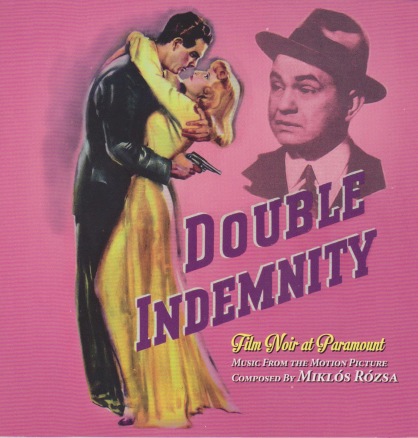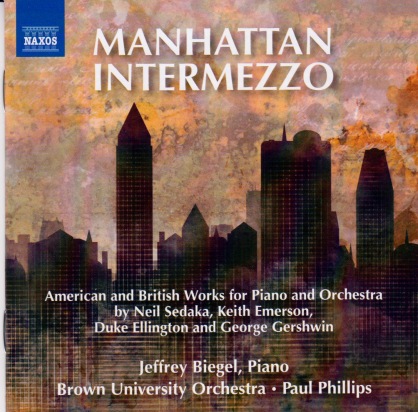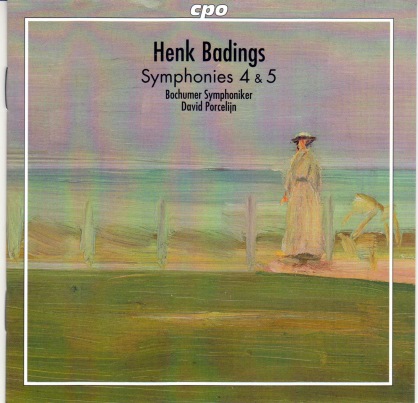Film Noir at Paramount Double Indemnity
February 25, 2016

One of the things that I try to do if it is possible while preparing for a soundtrack review, especially if it is a favorite of mine, is to read the novel, see the movie, and do some background material on the making of the movie. In the case of “Double Indemnity” this was a relatively easy thing to do except for one thing. This score has really never had a complete release except for the suite that Patrick Russ did and was recorded by Sedares and the New Zealand Symphony Orchestra in 1997. This is a score that was nominated for an Oscar and while certainly not his best score it is surely deserving of a OST release of some sort if this is possible. Intrada has released a 2 CD set called Film Noir at Paramount which includes “Double Indemnity,” “Ace in the Hole,” “Sorry, Wrong Number,” “The Desperate Hours,” “The Scarlet Hour,” “Union Station,” and “I Walk Alone.”
“Double Indemnity (1944) is considered by some to be the very best of the noir films that Hollywood ever produced. Starring Fred MacMurray, Barbara Stanwyck, and Edward G. Robinson the story was simply about murdering her husband, making it look accidental and collecting double indemnity on the insurance policy. Having the ingredients of a good noir there was a black widow and a double cross. James Cain wrote a masterful novel and it is ironic that Raymond Chandler, an excellent writer in his own right did the screenplay with Billy Wilder (another story in itself.). For Rozsa this score became somewhat of a template for future films “The Lost Weekend” and “The Killers.” and strengthened his hold on being an A+ composer for Hollywood. The score to my surprise transferred to a listenable mono recording that fared better than “The Lost Weekend.” The main title is one of yearning with little hope. It plods along at times with the brass playing a key part in both the harmony and melody. The second theme which appears in The Meeting is the complete opposite to the The Prelude in a major key not a minor. As source music at the end of the film is a selection from one of my all time favorite classical works, the unfinished symphony of Schubert. A added bonus is a stereo version of The Prelude a nice bonus selection.
Nearly 20 years ago Koch released three scores of Rozsa performed by the New Zealand Symphony conducted by James Sedares. “Double Indemnity” was included a 26+ minute suite. Unless one could find this CD at a reasonable price it is certainly not worth the $50.00 asking price on Amazon.The speed is at a snails pace compared to the new OST release.
Manhattan Intermezzo
February 18, 2016

NAXOS 8.573490
When Naxos sent me this recording of “Manhattan Intermezzo” it immediately got my attention because of the name and as I delved further into it I discovered the most unusual coupling of material of Sedaka, Emerson, Ellington, and Gershwin.
Neil Sedaka (1939) will be best known for his string of rock hits including “Breaking Up Is Hard to Do,” and “Calendar Girl.” When I first listened to “Manhattan Intermezzo” it sounded like nothing I expected at all. While we certainly cannot put this into the classification of true classical we could certainly compare it to “Rhapsody in Blue,” another selection on this platter. Repeated listens have revealed layers of different sounds of culture as well as painting a wonderful picture of Manhattan. The eighteen minute suite was arranged by film composer Lee Holdridge, a fine composer of many Hollywood films and with the permission of the composer Jeffrey Biegel was allowed to add his own embellishment to the work. This work is well worth the price of the CD and one that you’ll want in your collection for your phone etc.
Keith Emerson (1944) was part of the group Emerson Lake and Palmer and did a rock version of “Pictures at an Exhibition” that got my attention so the background was there for classical material. The 20 minute work is divided into three sections allegro, andante, and toccata. The first movement begins in a twelve tone fashion which is skittish, so much so that I nearly turned it off and went to the next selection. As I was about to do this the material changed into a melody which carries on in different rhythms, making it a unique blend of styles. The andante begins in a fugue fashion (hint) and quickly turns into a spirited easy on the ears short piece. The third movement again begins with more twelve tone material which is dissonant, loud with brash and powerful chords. To me this doesn’t sound like a toccata at all but more like something you would hear in a “On the Waterfront” like movie. Towards the end of the movement there is a respite from the dissonance and a melody appears all too briefly. Repeated listens have not helped as they sometimes do.
Duke Ellington (1899-1974) wrote big band standards, religious material, soundtracks to movies as well some great symphonic material which Naxos has made available to us on other CD’s. The work definitely has a big band sound which takes full advantage of this and blends nicely with the piano material. What you hear is a reconstruction of the original material from the 1943 Carnegie Hall concert in 1943 due to the fact that Duke never wrote much of it down or it was lost. “New World a-Comin'” fits into the category of “Rhapsody in Blue” style of music.
George Gershwin (1898-1937) has been written about enough that I won’t include it in this review other than when a group of us gathered one evening and posed the following question. What was the greatest work of the 20th century? It was the winner and for obvious reasons. Jeffrey Biegel uses the 1996 version prepared by Dr. Zizzo and careful listening will reveal the differences. The Brown University Orchestra under the direction of Paul Phillips performs as well as many orchestral recordings I’ve heard in many years of listening.
This is a fine CD and I applaud Naxos for offering this material to us. Recommended.
Henk Baddings Symphony No. 4 & 5
February 3, 2016

CPO777669-2
David Porcelijn conducts the Bochumer Symphony
One of the incredible bonuses of being able to review for Naxos is the introduction of new composers and music available to me. Such is the case with the Dutch composer Henk Badings (1907-1987) pedagogue and composer. His lack of popularity can be attributed to his dealings with the Nazi party during the war years. At one time his material was banned from being performed in his native country. As one Dutch friend put it so eloquently “The whole blacklisting was a bit McCarthy-esque as a great many composers, artists, bands and orchestras had signed up, simply because otherwise they would not be allowed to play (hence to make a living)!*) Principles are one thing, starvation another. Thankfully after about two years the zealousness of the immediate post-War righteousness had abated, and pretty much everyone who had not been an immediate collaborator or true propagator of Nazi propaganda or ideals was pardoned.”
The 4th Symphony was completed in December of 1943, had nothing to do with the war but instead is witty and has a natural sound that has truly grown on me during several listens to it. I don’t feel it is anything that you could compare to any of his contemporaries. He is unique and very melodic following a traditional Lento-Allegro, Scherzo, Largo, and Allegro format. It wasn’t performed until after the war in Rotterdam in 1947 dedicated to the conductor Eduard Flipse who also conducted the premiere. The opening movements begin with ominous chords like an oncoming storm that quickly dissipates into the introduction of the main theme with the trombones leading the way. After a brief opening the Scherzo turns into sweeping theme carried by the strings followed by another powerful burst of energy from the brass. The oboe and strings continue the memory with a hint of a fugue and staccato dissonant passages. It is a well done Scherzo and could very well find its way to my best of compilation CD’s, something that I’ve got for all types of allegros, andantes, vivaces, etc. The Largo is a yearning melancholy theme which reminds me of Strauss. The finale Allegro is somewhat slower than some but offers yet another strong melody which is passed from section to section nicely. This is a real winner.
The Fifth Symphony was a commissioned work for the 60th anniversary of the Concertgebouw Orchestra conducted by Eduard van Beinum, who had been a supporter of his music since the 30’s. The four movements are very similar to the 4th; Lento-Allegro, Scherzo, Largo, and Presto. The Lento-Allegro definitely has jazzy passages not unlike Ellington, Prokofiev, or early Shostakovich. While quite dissonant the melody is still layered in the material to filter through. The Scherzo is clearly modern sounding with short cells of dissonant material followed by quiet passages. The Largo reminds me of film music which was also noted by a 1955 review of the material. His harmony with the brass adds so nicely to the overall quietness of the movement. The finale, a Presto is a boisterous with yet another strong melody.
To my knowledge this is the third release of material from CPO of his works. I look forward to more material.
.